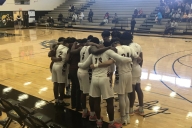You have /5 articles left.
Sign up for a free account or log in.
As the landmark antitrust lawsuit O’Bannon vs. National Collegiate Athletic Association trudges its way through the courts, studies on the monetary value athletes bring to their colleges seem more pertinent than ever. That lawsuit, which argues that athletes are entitled to a portion of that revenue, could ultimately compel the NCAA to adopt a more professionalized model.
Previous studies have found that under such a model, football and men’s basketball players in conferences in the top half of Division I, the Football Bowl Series are worth an annual average of more than $137,000 and $289,000, respectively. That’s well above the average full FBS annual scholarship, which is worth $23,000.
Now, comparing salary sharing as a portion of revenue in professional sports to scholarship funding as a portion of revenue in athletic departments, a new working paper published by Cornell University’s Higher Education Research Institute takes a different angle to make the same point: college athletes are being robbed.
"By restricting player remuneration," writes Jim Monks, associate economics professor at the University of Richmond, "the NCAA is quite effectively controlling player costs to the universities in order to allow athletic revenue to be used for other purposes."
Despite the two industries' comparable cash intake -- colleges and universities earned about $12.6 billion in athletics revenue in 2011, approaching double the $7.6 billion the National Football League made in 2009 -- salary shares in the major professional sports leagues of baseball, basketball, football and hockey all top 50 percent, Monks found, while in the 2011 academic year less than 20 percent of athletic revenue at NCAA institutions was used for scholarships.
“And it’s in kind -- it’s not in salary,” Monks said, referring to the fact that scholarship money can’t be used for anything other than tuition, fees, room, board and maybe a small stipend. “It’s the equivalent of returning something to the store and just getting store credit – you always prefer cash over store credit, because you can always use cash to buy something in-store.”
An NCAA spokesman said via e-mail that “The NCAA has not yet fully reviewed the paper, so we cannot comment at this time.”
As revenues increase, so too does spending -- and while scholarships are one of the biggest cost drivers, a lot of that money goes to facilities and coaching contracts as well.
And the programs that make the most money (and in turn, spend the most on top coaches and swanky buildings), those in the FBS, dedicated the smallest amount of revenue -- 15 percent -- to scholarships in 2011. Those athletic departments generate more than $6 billion annually, the report says, $938 million of which goes to scholarships.
The rest of Division I institutions, in the Football Championship Series, spend about 28 percent on scholarships, the report says. Division II spends from the low- to mid-30s percent range. (Division III institutions do not award athletic scholarships.)
Monks uses the difference in salary share to scholarship share to make the case that the NCAA and its member institutions are a “monopsonistic cartel" (operating in a market where there are many buyers but just one seller) – or at least way more monopolistic than professional sports leagues. (O'Bannon argues essentially the same thing, though Monks says his study is unrelated to the lawsuit.)
While Monks’s argument is “exactly right,” the Smith College economics professor Andrew Zimbalist said, it’s nothing new.
“[The NCAA does] it because they believe in an amateurism model and that the athletes are student-athletes, not professional athletes,” Zimbalist said. But if the NCAA wanted true amateurism, he said, it would ensure scholarships covered the full cost of attendance, and cap not just athletes’ remuneration but also the runaway salaries that sports administrators enjoy.
“They allow the coaches and the assistant coaches and athletic directors and conference commissioners to be paid at a level that’s well beyond what the college presidents get paid,” Zimbalist said, “and well beyond anything that’s economically justifiable.”
Common economic wisdom dictates that the higher the ratio of salaries to revenue, the lower the level of monopsony control, Monks writes.
"The professional sports leagues each have their own monopsonistic characteristics and practices, such as drafting of players, restrictions on the movement of players across teams, and salary caps," the paper says. "On the other hand, each of the professional sports leagues in the United States has a players’ union that enters into collective bargaining with the owners and acts as a body to advocate on behalf of the players."
One study argued last year that, because athletes operate in an “invisible labor market” that limits their rights and mobility while exploiting their money-making potential, they could indeed form a union of sorts – perhaps one that, drawing from labor laws for public safety employees, prohibits strikes but allows binding arbitration on some issues. Athletes more closely resemble professional athletes than amateur ones, the report said, and should be entitled to collective bargaining rights.
“Without a credible threat of unionization,” the University of Illinois law professor Michael LeRoy wrote, “schools have little incentive to concede that they are essentially professionalizing college football.”
Monks doesn’t think that day is coming particularly soon, nor that it it necessarily focus on wages (as opposed to, say, safety issues). But he pointed to the small-but-potentially-growing All Players United campaign, which a few athletes debuted this football season by wearing “APU” on their wrist tape during games to protest the NCAA’s handling of issues including concussions and lack of pay.
“I think it’s akin to the graduate students. For years, they weren’t allowed to collectively bargain or unionize because they said ‘No, you’re students…. it’s part of your education,' ” Monks said. “You’d be really hard-pressed to argue that playing basketball or football or soccer is a vital component to your education as an undergraduate.”








